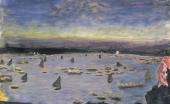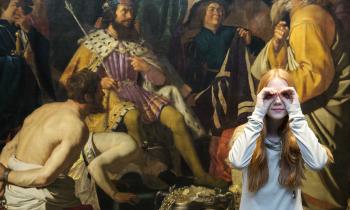Cornelis Schut (III)
Cornelis Schut (III)
This sheet resembles inv. no. 38672, cat. no. 147, also by Cornelis Schut III, in style and execution, and also bears similarities to works by Cornelis Schut I.[1]
A painting of Saint Teresa at Cádiz Cathedral by Cornelis Schut III has a very similar composition to this drawing. The lowest angel in the group to the left within the painting is identical to the one in the same position here, which allows us to date this work with some confidence from the period when Schut was in Cádiz, between 1668 and 1669 or slightly earlier.[2]
Saint Rose of Lima (1586-1617), the first saint in the New World, was canonized in 1671. Here, she kneels before a table or writing desk. A book resting on the floor seems to suggest that the saint was reading and dropped her book when the Christ Child arrived to crown her with roses. Born Isabel Flores de Oliva, she took the name Rose when she became a lay sister. She is depicted with a Dominican nun's habit, despite the fact that she never officially took those vows, and the roses that always appear around her allude to miracles such as the apparition of their blossoms around her face just a few months after she was born. Her mystical experiences led her to have various visions: the Christ Child appeared to her “in a very small form over a book she was reading... taking a few light steps across the paper," and again, when she was sewing (she was an expert seamstress and used embroidery as a memory aid for silent prayer). Here, he appears to crown her with roses, exchanging the metal crown with spikes half hidden in her veil for one made of roses and olives, in allusion to her surname.[3]
The present drawing closely resembles another on the same subject at the Museo Nacional del Prado, which was considered anonymous until now. The latter should, however, be attributed to Schut on the basis of its stylistic similarities to the Hamburg drawing.[4] The Prado's work has the same composition, but reversed and with slight modifications, such as a greater number of books (three instead of one) and different positions for the Christ Child (standing over the cherubs' heads in the Hamburg and sitting on them in the Prado) and the saint (in the former, she opens her arms in admiration, while in the Prado's drawing, she prepares to kiss the Christ Child's right foot).
Another drawing by Schut of the Christ Child appearing to Saint Rose dates from 1676 and is at the Casa de la Moneda in Madrid.[5] It reflects the moment when the Child appears to the saint in the garden, a scene also depicted by Bartolomé Esteban Murillo in a famous canvas at the Museo Lázaro Galdiano in Madrid (inv. 5310).
The beatification (1668) and canonization (1671) of this patron saint of the Hispanic dominions of the New World were causes for numerous celebrations in Spain, and it may be necessary to relate these drawings by Schut to a possible commission by the Dominicans in Seville for one of them, and also to the increased worship of Rose of Lima following the universal proclamation of her sainthood.
María Cruz de Carlos Varona
1. See a drawing 15 74 x 11 7/16 in. (400 x 290 mm) in Amsterdam, Rijksprentenkabinet, inv. RP-T-1980-20; Wilmers 1996, no. A 39 b (repr.).
2. Falcón 2005, 230; Durán González-Meneses 1980, no. 66.
3. See Mújica Pinilla 2009, no. 40, and Mújica Pinilla et al. 1995.
4. Pen and wash, brown ink over black pencil, 9 15/16 X 7 1/16 in. (252 x 180 mm), Madrid, Museo Nacional del Prado, D 274.
5. Durán González-Meneses 1980, no. 66; see Pérez Sánchez (dir.) 1995, 252, no. 109
Details zu diesem Werk
Beschriftung
Wasserzeichen / Kettenlinien
-
ca. 30 mm (h)
Provenienz
Wahrscheinlich José Atanasio Echevarría, Mexico (vgl. dessen Liste, „Colección de dibujos“, Nr. 58–63); Julian Benjamin Williams (1831-1856 Vizekonsul, dann bis 1866 Konsul in Sevilla); Frederick William Cosens (1819–1889), Sevilla; auf dessen Nachlassauktion bei Sotheby’s London am 11. 11. 1890 erworben vom Londoner Kunsthändler Bernard Quaritch (1819–1899); 1891 von diesem erworben
Bibliographie
Jens Hoffmann-Samland, with contributions by María Cruz de Carlos Varona, Gabriele Finaldi, José Manuel Matilla u. a.: The Spanish Gesture. Drawings from Murillo to Goya in the Hamburger Kunsthalle, Madrid 2014, S.244-245, Abb., Nr.148
Stefes, Annemarie: Niederländische Zeichnungen 1450-1850. Katalog II van Musscher - Zegelaar, hrsg. von Gaßner, Hubertus und Stolzenburg, Andreas, Die Sammlungen der Hamburger Kunsthalle Kupferstichkabinett, Bd. 3, Böhlau Verlag Köln Weimar Wien 2011, S.519, Nr.981
Pérez Sánchez: El dibujo español de los Siglos de Oro, Ausst.-Kat. Ministerio de Cultura, Dirección General del Patrimonio Artístico, Archivos y Museos, Madrid 1980, S.108, Nr.242, Abb.fig. 103
El Dibujo Espanol De Los Siglos De Oro, , Madrid 1980, S.108, Nr.242, Abb.S. CIII
Gertrude Wilmers: Cornelis Schut (1597-1655): A Flemish Painter of the High Baroque, Turnhout 1996, S.57, Abb.19







